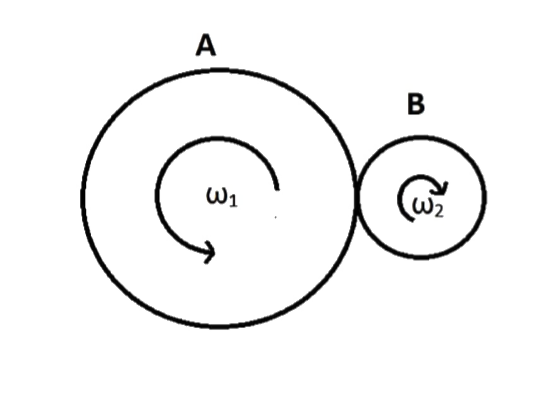Two disc having moment of inertias I1 & I2 and angle velocities ω1 & ω2 are placed coaxially find total kinetic energy when they rotates with same angular velocity I1=0.10Kgm2 I2=0.20Kgm2 ω1=10radsec ω2=5radsec
0 J
5 J
10 J
20/3 J
The correct Answer is:D
To find the total kinetic energy of the two discs when they rotate with the same angular velocity, we can follow these steps:
Step 1: Calculate the Initial Angular Momentum
The initial angular momentum Linitial of the system is the sum of the angular momenta of both discs. The formula for angular momentum is given by:
L=I⋅ω
Thus,
Linitial=I1ω1+I2ω2
Substituting the given values:
I1=0.10kgm2,ω1=10rad/s
I2=0.20kgm2,ω2=5rad/s
Calculating:
Linitial=(0.10×10)+(0.20×5)=1+1=2kgm2/s
Step 2: Determine the Final Angular Velocity
When the discs are brought together, they will rotate with a common angular velocity ω. The final angular momentum Lfinal can be expressed as:
Lfinal=(I1+I2)⋅ω
Setting the initial and final angular momentum equal gives:
Linitial=Lfinal
Thus,
2=(0.10+0.20)⋅ω
Calculating the total moment of inertia:
0.10+0.20=0.30kgm2
Now, substituting this into the equation:
2=0.30⋅ω
Solving for ω:
ω=20.30=203rad/s
Step 3: Calculate the Total Kinetic Energy
The total kinetic energy KEf when both discs are rotating with the same angular velocity is given by:
KEf=12I1ω2+12I2ω2
This can be simplified to:
KEf=12(I1+I2)ω2
Substituting the values:
KEf=12(0.10+0.20)(203)2
Calculating:
KEf=12(0.30)(4009)=0.30×40018=12018=203Joules
Final Answer
The total kinetic energy when both discs rotate with the same angular velocity is:
KEf=203Joules
The initial angular momentum Linitial of the system is the sum of the angular momenta of both discs. The formula for angular momentum is given by:
I2=0.20kgm2,ω2=5rad/s
When the discs are brought together, they will rotate with a common angular velocity ω. The final angular momentum Lfinal can be expressed as:
The total kinetic energy KEf when both discs are rotating with the same angular velocity is given by:
The total kinetic energy when both discs rotate with the same angular velocity is:
Topper's Solved these Questions
Similar Questions
Two bodies have their moments of inertia I and 2I, respectively about their axis of rotation. If their kinetic energies of rotation are equal, their angular velocity will be in the ratio
View SolutionTwo coaxial discs, having moments of inertie I1 and I12 are rotating with respective angular volecities ω1 and ω12, about their common axis.They are brought in contact with each other and thereafter they rotate with a common angular volecity.If Ef and Ei are the final and initial total energies, then (Ef−E1) is:
View Solution
Knowledge Check
Two bodies have their moments of inertia I and 2I respectively about their axis of rotation. If their kinetic energies of rotation are equal, their angular momenta will be in the ratio.
A12B√2C1:√2D21Two discs of moments of inertia I1 and I2 about their respective axes , rotating with angular frequencies ω1 and ω2 respectively, are brought into contact face to face with their axes of rotation coincident. The angular frequency of the composite disc will be
Aa. I1ω1+I1ω2I1+I2Bb. I2ω1+I1ω2I1+I2Cc. I1ω1−I2ω2I1−I2Dd. I2ω1−I1ω2I1−I2
The angular momentum of a body with mass (m) moment of inertia (I) and angular velocity (ω) rad/s is equal to
View SolutionTwo bodies with moment of inertia I1 and I2(I1>I2) have equal angular momenta. If their kinetic energy of rotation are E1 and E2 respectively, then.
View Solutionthe angular velocity omega of a particle varies with time t as ω=5t2+25rads. the angular acceleration of the particle att=1s is
View SolutionTwo discs of moment of inertia 9kgm2 and 3kgm2were rotating with angular velocity 6 rad/sec and 10 rad/sec respectively in same direction. They are brought together gently to move with same angular velocity. The loss of kinetic energy in Joules is______.
View SolutionTwo discs of moment of inertia I1 and I2 and angular speeds ω1 and ω2 are rotating along the collinear axes passing through their center of mass and perpendicular to their plane. If the two are made to rotate combindly along the same axis the rotational K.E. of system will be
View SolutionTwo discs A and B are in contact and rotating with angular velocity with angular velocities ω1andω2 respectively as shown. If there is no slipping between the discs, then

View Solution
